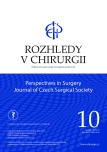Pulmonary metastases in pseudomyxoma peritonei – case report and review of the literature
Authors:
P. Horák 1; P. Holečková 2; Z. Špůrková 3; J. Marvan 1; F. Antoš 1; J. Fanta 1
Authors‘ workplace:
Chirurgická klinika 1. lékařské fakulty Univerzity Karlovy a Nemocnice Na Bulovce, Praha
1; Ústav radiační onkologie, 1. lékařská fakulta Univerzity Karlovy a Nemocnice Na Bulovce, Praha
2; Patologicko-anatomické oddělení, Nemocnice Na Bulovce, Praha
3
Published in:
Rozhl. Chir., 2020, roč. 99, č. 10, s. 462-466.
Category:
Case Report
Overview
Pseudomyxoma peritonei is a rare disease caused by dissemination of cancer forming mucous and gelatinous masses in the peritoneal cavity. Local recurrence is frequent; however, dissemination outside the peritoneal cavity is rare.
Case report: We present the case report of a female patient treated for bilateral pulmonary metastases from pseudomyxoma peritonei. We removed 1 metastasis from her left lung and 12 metastases form her right lung. The patient remained in a good clinical state; however, additional lung metastases developed, as well as a metastasis in L2 vertebra for which the patient underwent a surgical procedure.
Conclusion: Cytoreductive surgeries for intrathoracic involvement in pseudomyxoma peritonei with additional hyperthermic cytostatic intrapleural lavage in case of pleural involvement can lead to a longer lifespan in indicated patients.
Sources
- Carr NJ, Cecil TD, Mohamed F, et al. Peritoneal Surface Oncology Group International. A consensus for classification and pathologic reporting of pseudomyxoma peritonei and associated appendiceal neoplasia: The results of the Peritoneal Surface Oncology Group International (PSOGI) Modified Delphi Process. Am J Surg Pathol. 2016;40(1):14−26. doi: 10.1097/PAS.0000000000000535.
- Bibi R, Pranesh N, Saunders MP, et al. A specific cadherin phenotype may characterise the disseminating yet nonmetastatic behaviour of pseudomyxoma peritonei. Br J Cancer 2006;95(9):1258–1264. doi: 10.1038/sj.bjc.6603398.
- Antoš F, Vítek P, Kopic J, et al. Cytoreduktivní chirurgie a hypertermická peroperativní chemoterapie (HIPEC) v léčbě malignit peritoneálních povrchů. Onkologická revue 2018;5(2):62–67.
- Mortman KD, Sugarbaker PA, Shmookler BM, et al. Pulmonary metastases in pseudomyxoma peritonei syndrome. Ann Thorac Surg. 1997;64(5):1434–1436. doi: 10.1016/S0003-4975(97)00806-0.
- Ababneh R, Piso P, Hofmann HS, et al. An invasive treatment of pseudomyxoma peritonei with intrathoracic involvement. MAEDICA – a Journal of Clinical Medicine 2016;11(5):72−75.
- Geisinger KR, Levine EA, Shen P, et al. Pleuropulmonary involvement in pseudomyxoma peritonei. Morphologic assessment and literature review. Am J Clin Pathol. 2007;127:135−143. doi: 10.1309/601K2L2T7CR5U7G1.
- Beane JD, Wilson GC, Sutton JM, et al. Pleuropulmonary recurrence following cytoreductive surgery and hyperthermic intraperitoneal chemoperfusion for appendiceal pseudomyxoma peritonei. Ann Surg Oncol. 2019;26:1429–1436. https://doi.org/10.1245/s10434-018-07091-z.
- Lee BY, Kim HS, Lee SH, et al. Pseudomyxoma peritonei: extraperitoneal spread to the pleural cavity and lung. J Thorac Imaging. 2004;19(2):123−126. doi: 10.1097/00005382-200404000-00013.
- Pestieau SR, Esquivel J, Sugarbaker PH. Pleural extension of mucinous tumor in patients with pseudomyxoma peritonei syndrome. Ann Surg Oncol. 2000;7:199–203. doi: 10.1007/BF02523654.PMID: 10791850.
- Pestieau SR, Wolk R, Sugarbaker PH. Congenital pleuroperitoneal communication in a patient with pseudomyxoma peritonei. Journal of Surgical Oncology 2000;73(3):174–178. doi: 10.1002/(sici)1096-9098(200003)73:3<174:aid-jso12>3.0.co;2-u.
- Grotz TE, Mansfield PF, Royal RE, et al. Intrathoracic chemoperfusion decreases recurrences in patients with full-thickness diaphragm involvement with mucinous appendiceal adenocarcinoma. Ann Surg Oncol. 2016;23(9):2914–2919. doi: 10.1245/s10434-016-5209-0.
- Sugarbaker PH, Chang D, Stuart OA. Hyperthermic intraoperative thoracoabdominal chemotherapy. Gastroenterol Res Pract. 2012;623417. doi: 10.1155/2012/623417.
- Ahmed S, Levine EA, Randle RW, et al. Significance of diaphragmatic resections and thoracic chemoperfusion on outcomes of peritoneal surface disease treated with cytoreductive surgery (CRS) and hyperthermic intraperitoneal chemotherapy (HIPEC). Ann Surg Oncol. 2014;21(13):4226–4231. doi: 10.1245/s10434-014-3891-3.
- Kawaguchi Y, Hanaoka J, Ohshio Y, et al. Patient survival after surgical management in intrathoracic pseudomyxoma peritonei. Ann Surg Oncol. 2019;26:238–243. doi: 10.1245/s10434-018-6991-7.
- Kawaguchi Y, Hanaoka J. Cytoreductive surgery and hyperthermic chemotherapy for intrathoracic pseudomyxoma peritonei. Ann Thorac Surg. 2020;15:S0003−4975(20)30927–30929. doi: 10.1016/j.athoracsur.2020.04.114.
Labels
Surgery Orthopaedics Trauma surgeryArticle was published in
Perspectives in Surgery

2020 Issue 10
Most read in this issue
- Postoperative chylothorax − review
- Hyperthermic intraoperative intrapleural chemotherapy and surgical cytoreduction as part of multimodal treatment of malignant pleural mesothelioma – case report M. Szkorupa1, D. Klos1, J. Chudacek1, J. Hanuliak1, M. Stasek1, O. Fischer2, R. Lemstrova3
- Malignancy after lung transplantation
- Role of extracorporeal life support in thoracic surgery
